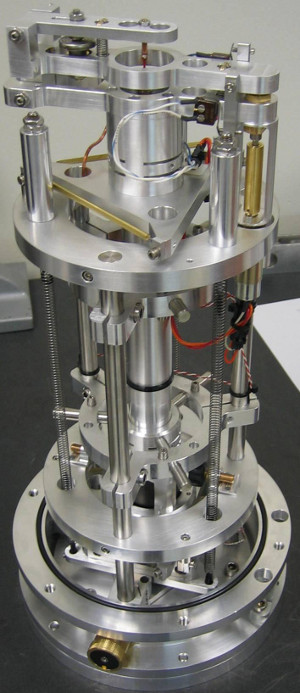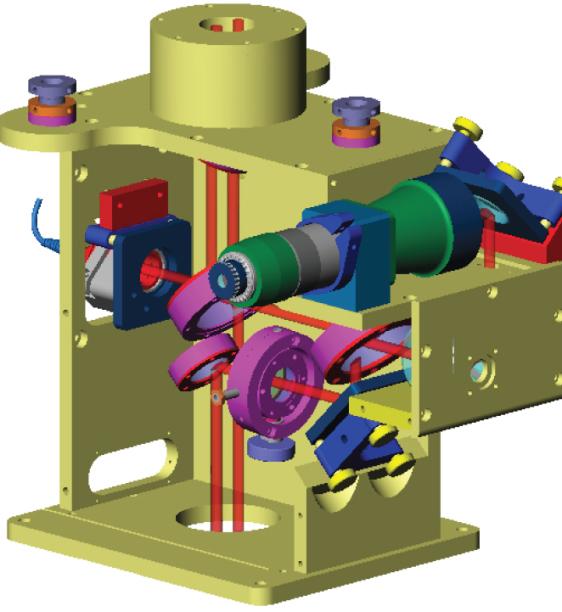Absolute Gravimetry
Measuring the acceleration due to gravity at the Earth's surface can reveal the vertical motion of the Earth's crust as well as mass changes above and below the instrument.
Gravity binds the universe together, directing the motion of galaxies and fixing our feet to the surface of our planet. The strength of the force we feel on the surface of the Earth is not constant, it varies with distance from the centre of mass and the changing density of the atmosphere above us and the solid Earth below us.
The Earth is also an elastic body constantly being manipulated and changed by the forces acting upon it. To understand more about the local response around the SGF and to compliment the techniques of SLR and GNSS, an FG5 absolute gravimeter has been in operation since 2006.
The measurement of gravity can be simply achieved by tracking an object as it falls, if you throw a ball taking measurements of time and distance during its flight and using the equations of motion, it is possible to calculate the acceleration of gravity. However with an accuracy of 2 µGal (or 0.00000002 ms-2) the FG5 is quite simply the most accurate method of directly determining gravity.
The FG-5 is a ballistic, or free-fall, device where the measurement of gravity is derived by dropping an object that is ‘tracked’ in flight using an interferometer.
 The FG-5 comprises five main components which are; the dropping chamber, interferometer, super-spring assembly, the laser and the electronics rack.
The FG-5 comprises five main components which are; the dropping chamber, interferometer, super-spring assembly, the laser and the electronics rack.Within the dropping chamber, which is at vacuum, an object which comprises a cart and a corner cube can be raised or dropped through a distance of 20 (FG5) or 33(FG5-X) centimetres. The dropping chamber is maintained at vacuum by use of an ion pump and sits upon its own tripod, to isolate it from the other components of the FG5, most importantly from the super-spring component, as the vibrations created in the movement of the cart within the chamber are significant, but even so the recoil from the floor of from the tripod can be easily detected in the individual drop residuals.
Below the dropping chamber and central to the design of the FG-5 is a modified Mach-Zender interferometer. A collimated continuous wave 633nm laser beam enters into the side of the interferometer and is split into two optical arms, one arm straight through the beam splitter to generate a reference arm whilst the other is reflected up into the dropping chamber to reflect off of the corner cube before being reflected down to another corner cube within the ‘super-spring’ assembly which is then recombined inside the interferometer with the reference arm of light. These recombined arms of laser light generate the interference fringes which form the basis of the determination of gravity.
To provide an inertial reference frame and vibration isolation from the high frequency natural micro-seismic activity of the planet, the FG-5 has a unique super-spring component (or assembly) which is coupled to the interferometer above it.
The super-spring uses a spring system with a natural period of 60s and is provided with oscillation dampening. This assembly removes the micro-seismic noise (around 6s-16s in period) from the measurements but is unable to compensate for larger seismic activity such as those generated from; earthquake events, extreme weather over oceans and a variety of other sources, mainly man made.
The SGF operates the FG5 at high frequency, aiming to take measurements each week.
In collaboration the Quantum Technologies Hub in Sensors and Timing with the University of Birmingham the SGF is working to improve our geodetic data output from our gravity sensors by the removal of hydrological influences on the data. The SGF will be testing new quantum gravity sensors as part of a research grant from EPSRC/NERC.
The testing is important in understanding characteristics/capabilities of the new sensors, such as drift, accuracy and precision, and is essential in developing these sensors.



